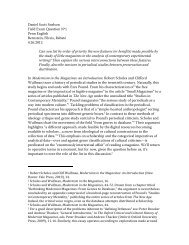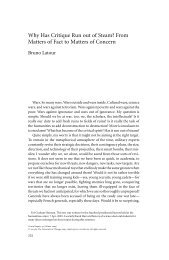The Exploit: A Theory of Networks - asounder
The Exploit: A Theory of Networks - asounder
The Exploit: A Theory of Networks - asounder
Create successful ePaper yourself
Turn your PDF publications into a flip-book with our unique Google optimized e-Paper software.
54 Nodes<br />
While the first type <strong>of</strong> network (Internet protocols) is silicon based and<br />
may use biological concepts (intelligent agents, artificial life, genetic algorithms),<br />
the second (DNA algorithms) is fully biological and yet recodes itself<br />
in computational terms (biology as computation, as opposed to evolution).<br />
Two “computers,” two networks—two protocols? Yes and no. <strong>The</strong><br />
example <strong>of</strong> DNA computing suggests that protocological control can<br />
be biological as well as computational. But what is the protocol? On<br />
the one hand, the aim <strong>of</strong> the experiment is mathematical and computational,<br />
yet on the other, the medium through which this is realized<br />
is biological and biochemical. So while computational protocols<br />
(flow control, data types, callback methods) may govern the inner<br />
workings <strong>of</strong> the informatic component <strong>of</strong> DNA computing, protocols<br />
also govern the interfacing between wet and dry, between the informatic<br />
and the biological. So there are two orders happening simultaneously.<br />
In the example <strong>of</strong> TCP/ IP, protocological control is almost<br />
exclusively mathematical and computational, with the wetware being<br />
left outside the machine. Protocols facilitate the integration and standardization<br />
<strong>of</strong> these two types <strong>of</strong> networks: an “inter” network relating<br />
different material orders (silicon and carbon), and an “intra” network<br />
relating different variables within protocological functioning (nodes<br />
as DNA; edges as base pair binding). <strong>The</strong> protocol <strong>of</strong> biocomputing<br />
therefore does double the work. It is quite literally biotechnical, integrating<br />
the logics and components specific to computers with the<br />
logics and components specific to molecular biology.<br />
This is to emphasize a point made at the outset: protocol is a materialized<br />
functioning <strong>of</strong> distributed control. Protocol is not an exercise<br />
<strong>of</strong> power “from above,” despite the blatant hierarchical organization<br />
<strong>of</strong> the Domain Name System or the rigid complementarity grammar <strong>of</strong><br />
DNA. Protocol is also not an anarchic liberation <strong>of</strong> data “from below”<br />
despite the distributive organization <strong>of</strong> TCP/ IP or the combinatory<br />
pos sibilities <strong>of</strong> gene expression. Rather, protocol is an immanent expression<br />
<strong>of</strong> control. Heterogeneous, distributed power relations are the<br />
absolute essence <strong>of</strong> the Internet network or the genome network, not<br />
their fetters. Thus the relation between protocol and power is somewhat<br />
inverted: the greater the distributed nature <strong>of</strong> the network, the









